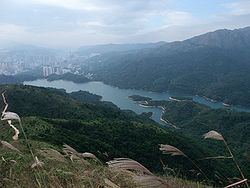Location Hong Kong | Type Reservoir | |
 | ||
Similar Shing Mun Country Park, Kowloon Group of Reservoirs, MacLehose Trail, Tai Mo Shan, Lead Mine Pass | ||
Jubilee (Shing Mun) Reservoir (Chinese: 城門水塘; Hong Kong Cantonese: sing4 moon4 sui2 tong4) is a reservoir in Hong Kong. It is located in Shing Mun, the area between Tsuen Wan and Sha Tin, in the New Territories.
Contents
Map of Upper Shing Mun Reservoir, Lo Wai, Hong Kong
History
Several hundreds years ago, the area around the reservoir was a dense forest with very few inhabitants. At least from 1646 to 1659, Southern Ming loyalist Li Wanrong (李萬榮), leading a cohort numbering in thousands, controlled Kowloon and much of today's New Territories, collecting taxes and fortifying villages, including erecting a fortress in the lower part of the Shing Mun River valley. Hence the area became known as Shing Mun or "fortified gate".
After 1669, when the Great Clearance imposed by the Kangxi Emperor of the Qing dynasty was rescinded, many Hakkas settled in this area, growing rice, tea and pineapples. In the early 20th century, there were seven villages in the area.
The Shing Mun Reservoir was built as part of the Shing Mun Water Supply Scheme formulated in 1923 to meet the increasing demand for fresh water due to the urbanisation of Kowloon. To a design by London dam engineers Messrs Binnie, Deacon & Gourley, construction began in 1933 of a dam 122 metres wide and 35 metres high which, upon completion, had a capacity of 4 billion litres. By the conclusion of Phase Three of the scheme in 1937, the dam had been extended to 85 metres in height and 13.6 billion litres capacity. The name Jubilee Reservoir (銀禧水塘) was designated to celebrate the Silver Jubilee (1935) of King George V of the United Kingdom, though the name has fallen into disuse.
The local inhabitants were resettled in other parts of the New Territories, and now some of the old villages are submerged. The remains of other villages and houses can be seen in the woods on the side of the reservoir. The remains of Gin Drinkers Line on the nearby hills show the defences of British forces against the Japanese invasion during World War II.
It is possible to see many troops of macaque monkeys around the picnic sites and in the woodland areas. To preserve the natural environment of the reservoir, its surrounding area is managed under Shing Mun Country Park. Two walking trails, Wilson Trail and MacLehose Trail, cross at the side of the reservoir.
Monument declaration
A total of 41 pre-World War II waterworks structures located in six reservoir areas, namely Pok Fu Lam Reservoir, Tai Tam Group of Reservoirs, Wong Nai Chung Reservoir, Kowloon Reservoir, Shing Mun (Jubilee) Reservoir and Aberdeen Reservoir, were declared as monuments in September 2009. The Memorial Stone of Shing Mun Reservoir was declared as one of the monuments.
